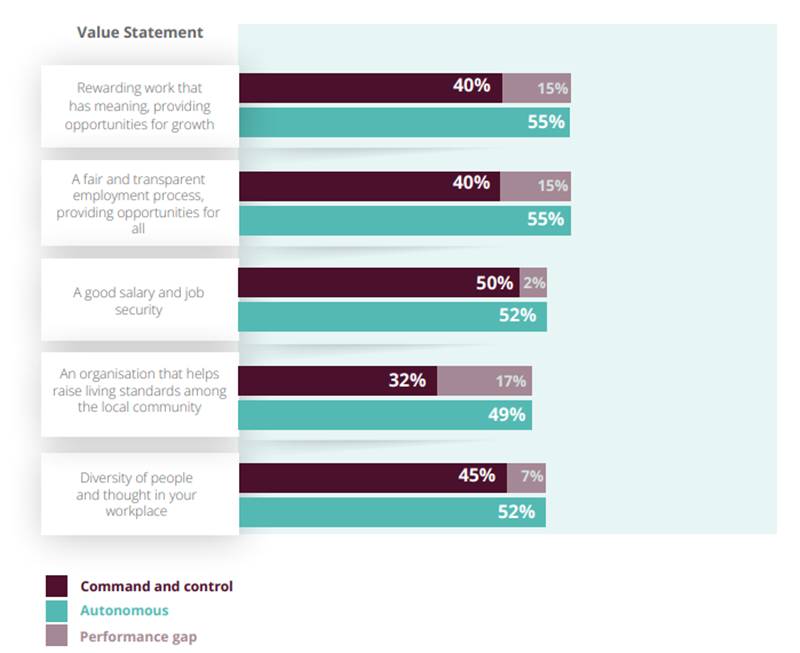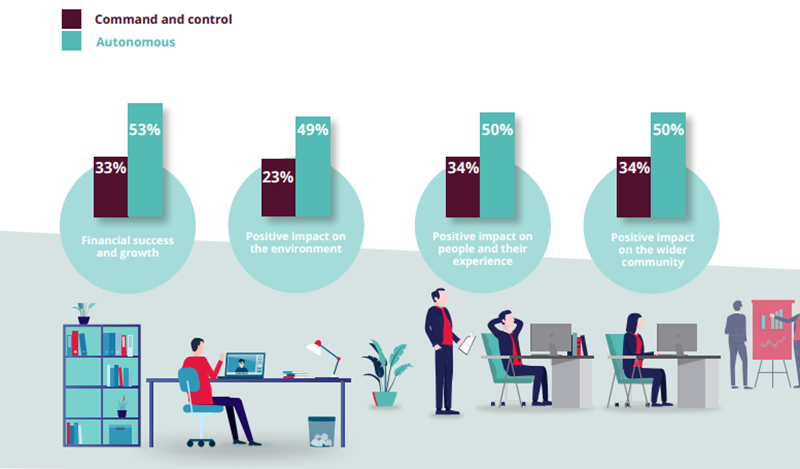Autonomous organisations perform best (Latest Research)
Giving your team the autonomy they want is good for your business and can make a real impact to your corporate culture and creating a positive workplace. Our 2021 research, Autonomy to the People, uncovered the data to prove this. This ground-breaking research was the precursor to our 2022 research ‘Powering Profits and Prosperity’, which delves further into why autonomous working styles are the way forward for successful and growing businesses.

Our initial research showed a clear disconnect between the way organisations operate, and the way people want them to. This year we found that greater autonomy is also a powerful psychological lever for engaging employees and helping them grow as individuals - as well as delivering benefits to the organisation.
And there’s a number of good, research-backed reasons that organisations should consider moving towards an autonomous style. The benefits of being part of such an organisation aren’t limited to the fact that people are able to shape their work and work environment. Our analysis shows organisations employing an autonomous approach to work, experience better business outcomes across every single outcome we measured.
Better outcomes all round
The ability to deliver against a range of business outcomes is more evident in organisations employing an autonomous working style, compared to those who work in organisations that operate a more command and control environment. Across five measures, there was an average 13% gap between the two styles in terms of being able to meet the outcomes. The largest gaps occurred in ‘creating a thriving partner network’, ‘customer loyalty’ and ‘retaining talent’.
Perhaps part of the answer as to why people in autonomous working environments believe their organisation is more successful lies in their willingness to go above and beyond, and what motivates them. Respondents from organisations using autonomous models are more engaged (45%) and more willing to go above and beyond (37%) compared to those in command and control organisations - 31% and 30% respectively.
In terms of what motivates people, those in command and control working environments are more driven by tangible benefits or perks such as more pay and leave (75%), compared to just 54% in autonomous organisations. For the latter, the ability to choose how and where they worked (57%) and strong leadership (56%) featured top of their motivations. Proving that once again, it’s not always about the money.
There was also another significant difference. Thirty-nine percent of people working in autonomous organisations said that a ‘workplace that prioritises efforts to help the local community and environment’ would make them more willing to go above and beyond, compared to just 26% in command and control style businesses. Again, this highlights the more rounded approach autonomous organisations have when it comes to motivations and a focus on societal responsibility.
What do we mean by ‘Autonomy’ versus ‘command and control’?
- Autonomous working style: Teams and individuals can shape their work and work environment to achieve the goals they are set.
- Command and control working style: Teams and individuals’ work and work environments are governed by an organisation’s standards, procedures, and output metrics.
Autonomy creates more value
People working in autonomous environments believe their organisation performs better across all 16 value statements, when compared to those working in a command and control environment. Overall, a 14% average gap exists in performance between autonomous and command and control organisations.
When it comes to some of the most important considerations:

So why do people working in organisations employing an autonomous working style say their organisation performs better across our 16 value statements, compared to those in command and control? A lot of that answer may lie in the extent to which all people within an organisation help to drive economic, ecological, psychological and societal success.
Only a third of respondents said that all people within their organisation help drive a range of successful outcomes. Yet for those working in autonomous environments, the story is very different. On average just over half of people say this to be the case and nearly 20% are more likely to say those outcomes are driven by all people in the business compared to those in command and control environments.
Across a range of measures, it’s clear those people working in autonomous organisations feel more involved with, connected to, and positive about their business delivering not just for them, but for a variety of stakeholders.

This is a key point when we remember how top-down ESG strategies and initiatives are more prone to failure or ineffectiveness. “Lofty ESG goals can be ‘pretty meaningless for staff’, says Richard Collins, co-founder of CSR Accreditation, a training organisation. ESG measures, which can be manipulated, are imposed top-down, whereas genuine CSR activity is bottom-up, and involves people. Collins recommends aligning social responsibility with what your business does.
Making grand claims about your ethical purpose while conducting business as usual can be doubly disheartening. An autonomous working style clearly benefits organisations in being able to deliver not only financial outcomes, but environmental, societal and psychological factors too. Not only does this matter to their people, but their organisations are also performing well, and their people feel very much involved in helping to shape their direction too.
Autonomous organisations really do it best
The research shows organisations achieve better outcomes in many areas when teams and individuals can act more autonomously. The desire for autonomy is shared by managers and employees alike.
As we’ve discovered, an autonomous working style really does help power profits and the prosperity of our people, communities and society - in fact, the entire business ecosystem. Operating in this way enables profits and prosperity to be built from the ground-up and become central to an organisation’s strategy. This ensures ecosystem initiatives are more believable, involved and of course valuable to performance. And this occurs because of the core fundamentals of operating in an autonomous environment; that is the ability to get the right data and information into the hands of people, who in turn can make informed decisions to drive optimal performance.
If organisations want to continue to be successful and achieve sustainable, long-term growth, they should consider exactly what Powering Profits and Prosperity means to their people and how they can deliver upon it. What we know from our research is that working autonomously goes a long way towards helping to achieve this goal.
Download the full Powering Profits and Prosperity report, or explore more on the Access Research Hub.










